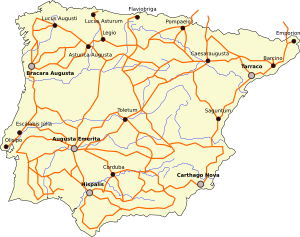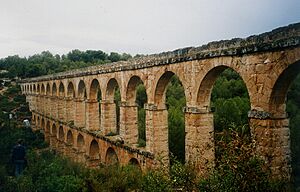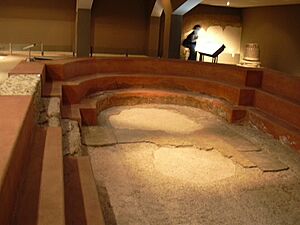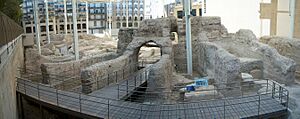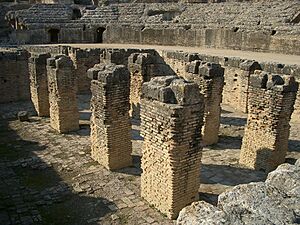Romanization of Hispania facts for kids
The Romanization of Hispania was a time when the Roman way of life, including their culture, was brought to the land we now call the Iberian Peninsula (Spain and Portugal). This happened during the time when Rome ruled this area.
Over hundreds of years of Roman rule in the provinces of Hispania, Roman customs, religion, laws, and their general lifestyle became very popular among the local people. Many Roman immigrants also moved there. Together, they created a unique Hispano-Roman culture.
Several things helped this Romanization process:
- Building new infrastructure like road networks and city sanitation systems.
- Trading with other regions and with the wider Roman world.
- Starting new cities called coloniae. These were towns where Roman soldiers who had finished their service could settle.
- Spreading the Roman system of government throughout the Hispanic provinces.
- Large Roman farms (called latifundia) grew bigger.
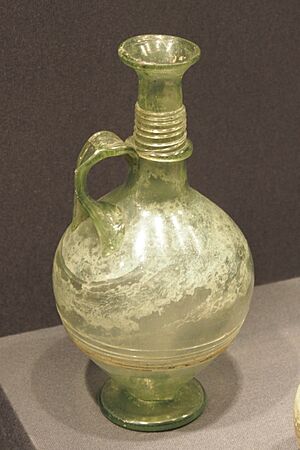
Contents
Roman Cities: How They Grew
Roman influence greatly changed the cities that were already there. But the biggest building projects were focused on brand-new cities. Some important new cities were Tarraco (today's Tarragona), Emerita Augusta (now Mérida), and Italica (near Seville).
Roman towns were designed to be like smaller versions of the capital city, Rome. Public buildings were overseen by special officials. They were managed by the city's main leaders.
To use public money for any building project, permission from the emperor was needed. Local pride and generosity also encouraged cities to compete. This led to wealthier and more beautiful neighboring towns.
Public projects built with private money did not need the emperor's approval. City planners decided how much space was needed for houses, squares, and temples. They also planned the amount of water needed and the number and width of streets. Soldiers helped build the cities, along with local craftspeople and slaves.
Tarraco: A Key Roman City
Tarraco started as a Roman military camp. It was set up by two brothers, Gnaeus and Publius Cornelius Scipio, in 218 BC. They landed on the Iberian Peninsula during the Second Punic War. The writer Pliny the Elder called Tarraco "the work of the Scipios."
Tarraco was the capital of Hispania Citerior during the Roman Republic. Later, it became the capital of the huge Hispania Citerior Tarraconensis Province. Around 45 BC, Julius Caesar likely made it a colonia. This is why its full name was Colonia Iulia Urbs Triumphalis Tarraco. This name stayed throughout the Roman Empire.
Emerita Augusta: A Soldier's Home
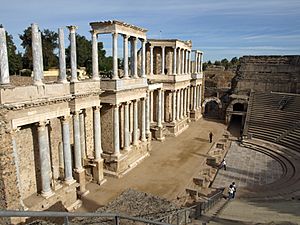
Emerita Augusta was founded in 25 BC by Publius Carisio. He was representing the emperor Octavian Augustus. It was a place for soldiers from the Fifth Legion and Tenth Legion to retire. Over time, this city became one of the most important in Hispania. It was the capital of the province of Lusitania and a center for business and culture.
Italica: Birthplace of Emperors
Italica (now Santiponce near Seville) was the first truly Roman city founded in Hispania. After the Second Punic War, Scipio Africanus gave land to Roman soldiers in the Betis river valley (now the Guadalquivir). Italica began as a hospital for wounded soldiers from the Battle of Ilipa. Later, it became a settlement for war veterans. It was founded in 206 BC.
Under Caesar Augustus, Italica became a municipality. This meant it had the right to make its own money. But it became most famous during the reigns of emperors Trajan and Hadrian in the 1st and 2nd centuries AD. These emperors were from Italica, which brought great respect to the city in Rome. Both emperors were very generous to their hometown. They helped it grow and become richer. Hadrian ordered the building of the nova urbs, or "new city."
During Hadrian's rule, Italica also became a Roman colony. It was renamed Colonia Aelia Augusta Italica to honor the emperor. By then, many important people in the Roman Senate were from this Spanish city.
Carthago Nova: A Strategic Port
The city was founded around 227 BC by the Carthaginian general Hasdrubal the Fair. He named it Qart Hadast, meaning "New Town." It was built in a great natural harbor. This location allowed control over the nearby silver mines of Carthago Nova. The Roman general Scipio Africanus captured it in 209 BC during the Second Punic War. This cut off the silver supply to the Carthaginian general Hannibal.
In 44 BC, the city was given the title of colony. Its name became Colonia Urbs Iulia Nova Carthago. In 27 BC, Augustus reorganized Hispania. The city was included in the new imperial province of Hispania Tarraconensis. Later, under Tiberius and Claudius, it became the capital of the conventus iuridicus Carthaginensis, a legal district.
During Augustus's rule, the city saw many new building projects. These included an impressive Roman theater, the Augusteum (a building for worshipping the emperor), and a forum.
Later, under Emperor Diocletian, it became the capital of the Roman Province of Hispania Carthaginensis. This province was separate from Tarraconensis.
Roman Military Buildings
The first types of buildings the Romans constructed in Hispania were military ones. This was because of their fight with the Carthaginians during the Second Punic War.
Roman Camps
Roman forts were central to Roman military plans. They could be temporary, built for a quick military task, or as a winter home for troops. These were often made with mortar and wood. They could also be permanent, built to control an area for a long time. These were often made of stone. Many camps grew into stable towns, eventually becoming real cities, like León.
City Walls
Once a settlement became a stable colony or camp, it needed strong walls for defense. The Romans learned about siege warfare from the Greeks. In the 2nd and 1st centuries BC, they built strong walls. These usually had two outer layers of stone with a filling of mortar, stone, and Roman concrete inside. The walls could be from four to ten meters thick (13 to 30 feet). After the period of Roman peace (Pax Romana), these defenses were not as needed. But the invasions by Germanic tribes brought back the need for wall construction.
Today, you can still see parts of Roman walls in cities like Zaragoza, Lugo, León, Tarragona, Astorga, Córdoba, Segóbriga, and Barcelona.
Roman Civil Engineering

The ancient Roman civilization is famous for building amazing infrastructure. They were the first civilization to seriously focus on these kinds of civil works. They saw them as essential for their cities, and for keeping military and economic control over their vast empire. The most important works were roads, bridges, and aqueducts.
City Infrastructure
These facilities, both inside and outside cities, were vital for how a city worked and for its economy. They allowed cities to get essential things like water through aqueducts, or food and goods through the efficient road network. Also, any city of average importance had a sewer system to drain wastewater and stop streets from flooding when it rained.
Roman Roads and Streets
The Romans built many roads for civilian use in Hispania. These roads connected Cadiz to the Pyrenees mountains and Asturias to Murcia. They covered the Mediterranean and Atlantic coasts, using routes that were already there. Along these roads, trade boomed. This helped keep the territory politically stable for several centuries.
Some of the most important roads were:
- Vía Lata, now known as Vía de la Plata; or the Silver Way.
- Via Augusta, the longest Imperial Roman road in Spain. It was 1500 km long and had many sections.
- Vía Exterior
To show distance along these roads, milestones were placed. These were columns or large stones that marked the distance from the starting point in thousands of steps (miles).
Today, most of these Roman routes match the layout of modern roads or highways in Spain and Portugal. This shows how smart the Romans were in choosing the best paths for their roads.
Roman Bridges
Roman bridges were a key part of the roads. They allowed people to cross rivers, which in the Iberian Peninsula can be very wide. Rome solved this geographical challenge with some of the most strong and reliable constructions. Rome also built many wooden bridges for smaller crossings. But today, only the stone ones have survived.
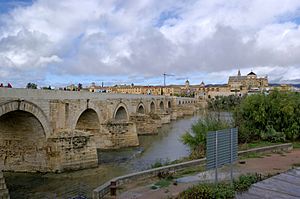
A typical Roman bridge had a flat top supported by arches. These arches were semicircles or parts of circles. Some bridges even had full circles. The parts of the bridge in the water had wedge-shaped structures called abutments. These helped redirect the water flow and supported the bridge itself.
This successful bridge design lasted until the late Middle Ages. Today, it's sometimes hard to tell if a bridge is truly Roman or if it was built later using the original Roman design.
Roman Aqueducts
An important town needed a constant supply of water for thousands of people. This water source could sometimes be several miles away. To get this continuous flow of water, the Romans built aqueducts.
Despite how they look, most Roman aqueducts were built underground. However, they are famous for the monumental parts built to cross valleys or other geographical barriers. The tall, slender design of these structures, along with their great height, makes them some of the most beautiful civil engineering works ever. This is especially true when you think about how difficult they were to build.
To build an aqueduct, first they needed a water source. They would channel a natural stream by building a canal. The slope of the land would carry water through this channel to an artificial lake or a large stone reservoir. This made sure there was a constant water supply all year.
From this point, the water could be carried by canals made of stone, or by pipes made of ceramic or lead. Lead pipes could cause health problems like lead poisoning. This problem lasted for a long time in places where lead pipes were used a lot. Lead piping was easier to work with. But it was mostly used in city water networks because it was expensive, and for aqueduct traps.

The water from the artificial reservoir was carried through an underground channel to the town. Often, they used natural slopes. But sometimes, the Romans also built "traps" or inverted siphons. These allowed them to avoid a downward slope without building the famous bridges. They kept the water flowing under pressure. These traps used the pressure from falling water to push it up on the other side. This kept the pressure, even if some water flow was lost. This is an example of the principle of communicating vessels.
Today, some famous aqueducts that are still in good condition include the aqueduct of Segovia. It is the most famous Roman structure in the Iberian Peninsula. Next is the aqueduct in Tarragona, also called the Devil's Bridge. There are also remains of the aqueduct of Mérida, known as the Miraculous Aqueduct.
Roman City Life and Buildings
Inside Roman cities, there were baths and sewers. But there were also amazing buildings for fun and culture, like theaters, circuses, and amphitheaters.
Roman Bathhouses
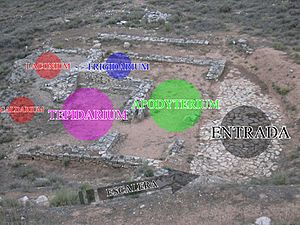
Roman culture valued the body and its health. Public baths became meeting places for people from all parts of society. The authorities encouraged their use, sometimes even paying for them so everyone could enter for free. Men and women sometimes shared the same spaces, but they had different bathing times. Women usually came in the morning, while men came in the evening. If there were separate sections for men and women, the women's areas were called spas.
In the Iberian Peninsula, there are many Roman bathhouse ruins. Some are very well preserved, like the Baths of Alange near Mérida. After several repairs in the 18th and 19th centuries, they are now open to the public as a medicinal water spa.
A Roman bathhouse was designed for its purpose, as shown in the diagram of Azaila. The apodyterium was the entrance and also a changing room. From there, you went to the tepidarium, a warm room. This room led to the frigidarium (cold water room) or the caldearium (hot water room). The hot water room was usually built facing south to get the most sunlight. Under the floor of this room were pipes that circulated hot water. In smaller bathhouses, they used a heating system called hypocaust heating. The frigidarium, however, was usually an open pool of cool water.
Generally, the bathhouse was surrounded by gardens and other buildings. These offered services like gymnasiums, libraries, or other meeting places (laconium). All of this was to give visitors a pleasant and refreshing experience. These bathhouses needed many staff members to operate. This was especially true because they needed large amounts of hot water, materials, and to serve customers properly.
Roman Sewers
From the very beginning, the Romans knew that a city needed a good system for waste disposal to grow. So, they built sewage systems in all important cities. In some cases, these systems are still in their original form today. For example, in Mérida, the Roman sewer system was used until recent years. Its design still helps us understand the layout of the ancient Roman city. In other cities like León (which started as a camp for the Legio VII Gemina), you can still see parts of these systems. They show how perfectly designed they were to prevent flooded streets on rainy days.
Roman Theatres
Classical literature, both Greek and Roman, is full of plays written for public performance. The Roman theater actually came from the Etruscan culture. But it quickly adopted features of ancient Greek tragedy and comedy.
Theater was one of the favorite pastimes for Hispano-Romans. Like other public buildings, any famous city had to have one. For example, the theater of Emerita Augusta was built almost at the same time as the rest of the city. It was built by the consul Marcus Agrippa, who was the son-in-law of Emperor Octavian Augustus. In total, we know of at least thirteen Roman theaters throughout the peninsula.
Roman theaters were used for more than just comedies or dramas. They were also places for celebrations that honored the emperor. So, they had a more political purpose, not just for entertainment. However, sometimes they did host all kinds of cultural shows. The large number of theaters in Hispania shows how important political life was in cities and towns. Everyone wanted their own theater to show off their status.
Another example is in the city of Baelo Claudia. This city has an impressive Roman theater inside its fortress, taking up a huge space. Its construction in a city where only houses have been found within the fortress suggests how important this civil building was. It showed the emperor's political power.
Without a doubt, the best-preserved theater in the Peninsula is in Mérida. But the theaters of Italica, Sagunto, Clunia, Caesaraugusta, and others are also important archaeological sites. Some even host modern theater festivals regularly. They are still serving the purpose for which they were built, in some cases more than two thousand years ago.
In the 1990s, the Roman Theatre in Cartagena was discovered and is currently being restored.
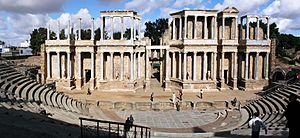
The reconstruction of Sagunto's theater, done between 1983 and 1993, is still very controversial. A court order requires that all the reconstruction work be torn down. This would return the theater to how it was before the work. However, it seems unlikely this order can be carried out. It might not be possible to protect the original theater during such a large demolition.
Roman Amphitheatres
Roman culture had different ideas about human life than we do today. The system of slavery meant that a person could lose their status as a "free man" for various reasons, like committing a crime, having debts, or losing a battle. After losing their rights, they were forced to take part in a type of entertainment that today would be considered very brutal. But at that time, it was one of the biggest attractions of city life: gladiatorial combat. Most gladiators were slaves or prisoners. But some people also chose a career as a gladiator and fought for money, favors, or fame. Even some emperors, like Commodus, sometimes went down into the arena to play this bloody "sport."
At first, fights took place in the circus. But then, people started building amphitheatres. These were oval-shaped buildings made only for fights. The first stone amphitheater was built in Rome. Its design was then copied in major cities across the empire. Under the arena of the amphitheater was a pit. This is where gladiators and wild animals were prepared or kept locked up until it was time to fight. This pit was covered by a wooden roof, which was the fighting area. Around this area were oval-shaped benches where the audience watched the "games." From the 1st century onwards, these arenas also saw brutal actions against the growing Christian population by the Roman authorities.
The Colosseum in Rome is the most famous and largest amphitheater in the world. But in Hispania, several were built whose remains have been preserved. These include Italica, Jerez, Tarragona, and Mérida.
How Roman Culture Spread in Hispania
Roman influence slowly spread across the peninsula over a long period of two centuries. Many local Iberian tribes were at first aggressive. They fought against Roman rule. But others became allies or groups that paid tribute to Rome. They became more and more dependent on Rome.
The Mediterranean coast was already home to native Iberians like the Turdetani and Ilergetians, as well as Greek and Phoenician/Carthaginian settlements. These areas quickly adopted parts of Roman culture. The first Roman cities, like Tarraco in the northeast or Italica in the south, were founded in these territories during the conflict with Carthage.
In the inner parts of the Iberian Peninsula, Celtiberian, Cantabrian, and Vasconian (Basque) cultures were well established. Constant military campaigns against the rebellious native Iberians eventually brought peace to the Hispanic provinces. This ended with Augustus's campaigns against the Cantabrians and Astures. The strong native Iberian culture slowly became less dominant. It was absorbed and changed into the later Hispano-Roman culture.
The new Hispano-Roman leaders were made up of the old Iberian tribal leaders and the growing Roman upper class. They took on government jobs in the new city institutions and the wider empire's administration. They served in legal, military, and civil roles. The expansion of Roman citizenship with the Antonine Constitution in 212 AD completely changed the idea of being "Roman." This helped native Iberian cultures become even more integrated. Three Roman emperors, Theodosius I, Trajan, and Hadrian, came from the Roman provinces of Hispania. So did famous writers like Quintilian, Martialis, Lucan, and Seneca.
See also
 In Spanish: Romanización de Hispania para niños
In Spanish: Romanización de Hispania para niños
- Lex Irnitana
- National Archaeology Museum (Portugal)
- Roman conquest of Hispania
- Roman Empire




